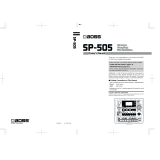
MSY2 Version 2 - User's Guide – Seite / Page 3
If desired you may connect the Clock output jack to the control input of another device (e.g. the
arpeggiator control input of a synthesizer or a drum machin with separate Clock input) to control it
with a MIDI synchronized Clock signal. Use a suitable cable. Normally a cable with a 1/4" mono
jack plug on one side (device) and a 3.5mm miniatur mono jack plug (MSY2) on the other side will
be used. Suitable cables are available from your local Doepfer representative.
POWER SUPPLY
MSY2 does not have a built-in power supply. It has to be supplied from an external power supply
(AC adapter). In Germany the power supply is included. In other countries it depends upon the
dealer or representative if the power supply is included or has to be ordered separately. The MSY2
will work with each AC adapter being in accordance with the following specifications: the adapter
must be able to deliver 7-15 V DC unstabilized or stabilized voltage, as well as a minimum current
of 100 mA. The POLARITY of the low voltage plug connected to the MSY2 must be pin = +7...15V
and ring = GND (see sketch on the MSY2 housing). If the polarity is incorrect, MSY2 will not
function. However, there is no danger of damage to the circuitry since it is protected by a diode. If
the MSY2 is used in Germany the external power supply must be VDE approved.
When using an external power supply the MSY2 is SWITCHED ON by plugging the AC adapter
into a wall outlet and connecting it to the jack labeled "9V DC" of the MSY1. There is no separate
ON/OFF switch.
OPERATION
After power on the Clock LED must light up and remain on until the first MIDI clock message
occurs. During this period the Clock LED works as a power indicator. If the Clock LED does not
light up the AC adapter used is not suitable or does not work, or the MIDI transmitter is already
sending MIDI Clock messages. In the last case you should set the MIDI transmitter to Stop mode
(normally by pressing a Stop button). Most MIDI devices stop transmission of MIDI Clock
messages during stop mode.
In case of an incoming MIDI START message (normally followed by MIDI CLOCK signals) the
START LED will light up and the CLOCK LED will flash indicating the tempo. Because of the inertia
of the eye higher frequencies are not perceptible.
In case of an incoming MIDI STOP message the Start/Stop LED turns off and normally the Clock
LED as well as most of the MIDI devices stop the transmission of Clock messages in Stop mode.
In case that the MIDI transmitter is sending Clock messages in the stop mode too the Clock LED
will continue flashing.
As soon as one of the two SYNC outputs of the MSY2 is connected to your device equipped with a
SYNC input socket it should respond to the MIDI messages, i.e. it should start, stop and change
the tempo via MIDI. If the two LEDs of the MSY2 display properly but your device does not
respond there is probably a fault in the connection between MSY2 and your device (unsuitable
cable) or the SYNC input of your device is not switched to SYNC In
or the SYNC input is not in
accordance with the SYNC standard.
If you want to slow down the SYNC clock frequency you may change the CLOCK DIVIDING
FACTOR. The factory setting is 1:1 conversion, i.e. each MIDI Clock trigger a SYNC Clock pulse.
To change the dividing factor you have change the setting of the first 4 DIP switches located at the
bottom of the MSY2 case. The dividing factor can be set between 1 and 16. The valences of the 4
DIP switches are 8, 4, 2, 1 (from left to right, see pictures 3 and 4).





